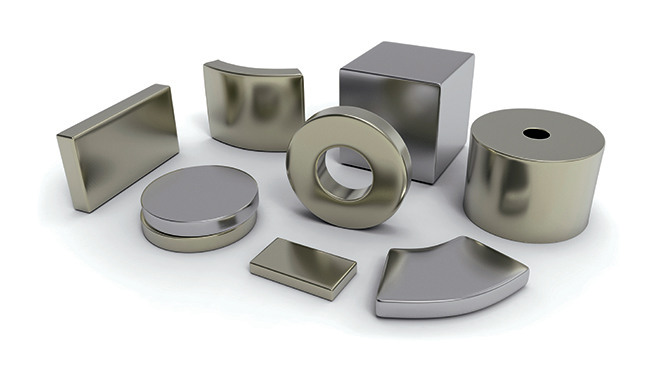Researchers from the DOE’s Critical Materials Institute (CMI) and Ames National Laboratory have developed a new method of manufacturing manganese bismuth (MnBi) magnets based on microstructure engineering.
They describe their wok in “Engineering microstructure to improve coercivity of bulk MnBi magnet,” published in the Journal of Magnetism and Magnetic Materials.
Permanent magnets used for electric motors are currently constructed from rare earth elements such as neodymium and dysprosium, which, according to researchers, are becoming increasingly harder to obtain. According to Wei Tang, a CMI researcher and Ames Lab scientist, by improving the properties of a rare-earth-free permanent magnet material such as MnBi, the researchers have made a step towards making compact motors without using rare earths.
Permanent magnets used for electric motors require high energy density or high levels of magnetism and coercivity—a magnet’s ability to maintain its current level of magnetism despite exposure to high heat and outside influences that could demagnetize it. The challenge with MnBi is that traditional manufacturing methods require high heat to transform the individual materials into a magnet, and the necessary heat reduces the energy density of the magnet. To address this problem, the team developed an alternative process.
Tang and his team started with a fine powder for each of the materials, which increases the starting magnetic energy level. Next, they used a warm heating method rather than a high-temperature method for forming the magnet. Finally, the key to their new process was to add a non-magnetic component that would keep the grain particles from touching each other. This additional element, called a grain boundary phase, provides more structure to the magnet and keeps the magnetism running through individual particles/grains from affecting adjacent areas.
The researchers expected the coercivity and magnetism to decrease with increasing temperature, which is true for most magnetic materials. However, for MnBi, the warm temperature increased the coercivity and decreased the magnetization. This increased coercivity helps to keep the magnet more stable at elevated temperatures than other known magnets.
“If we use high-power-density magnets, we can reduce the motor size and make a more compact motor,” said Tang. “Right now, it is very important that we can make some devices smaller, more compact and more energy-efficient.”
Source: Ames National Laboratory


lasuna medication – cheap lasuna online buy himcolin generic
generic besivance – buy sildamax pill sildamax order
buy generic neurontin 600mg – buy sulfasalazine 500 mg pills buy sulfasalazine without a prescription
order celebrex sale – urispas pill order indomethacin pill
cheap rumalaya pills – buy rumalaya pill buy elavil for sale
order cambia generic – cost aspirin buy aspirin online
buy mestinon generic – mestinon 60 mg brand imuran pills
lioresal online buy – buy piroxicam 20 mg pills order feldene 20mg generic
buy artane no prescription – cheap trihexyphenidyl sale buy diclofenac gel online cheap
order periactin 4 mg generic – tizanidine 2mg tablet tizanidine without prescription
buy accutane 20mg without prescription – accutane usa deltasone 20mg pill
buy omnicef 300 mg online – buy clindamycin medication where can i buy clindamycin
permethrin buy online – purchase retin generic tretinoin cream uk
prednisone 10mg drug – deltasone pills zovirax buy online
betamethasone 20 gm without prescription – differin ca where to buy benoquin without a prescription
cleocin pill – cleocin price indocin 50mg tablet
how to get augmentin without a prescription – cheap levoxyl buy levothyroxine without prescription
buy crotamiton without a prescription – purchase bactroban ointment cream aczone for sale online
order losartan 25mg generic – buy cozaar 25mg online cheap cost keflex
bupropion 150 mg canada – zyban usa shuddha guggulu generic
buy provigil 200mg online cheap – melatonin for sale melatonin where to buy
progesterone 100mg oral – clomiphene order fertomid drug
cost xeloda – order xeloda 500mg buy danazol generic
buy fosamax 35mg generic – cheap tamoxifen 10mg buy provera 10mg
yasmin sale – order estradiol generic buy anastrozole 1mg online
гѓ—гѓ¬гѓ‰гѓ‹гѓігЃ®йЈІгЃїж–№гЃЁеЉ№жћњ – жЈи¦Џе“Ѓгѓ—гѓ¬гѓ‰гѓ‹гѓійЊ гЃ®жЈгЃ—い処方 г‚ёг‚№гѓгѓћгѓѓг‚Їе‡¦ж–№